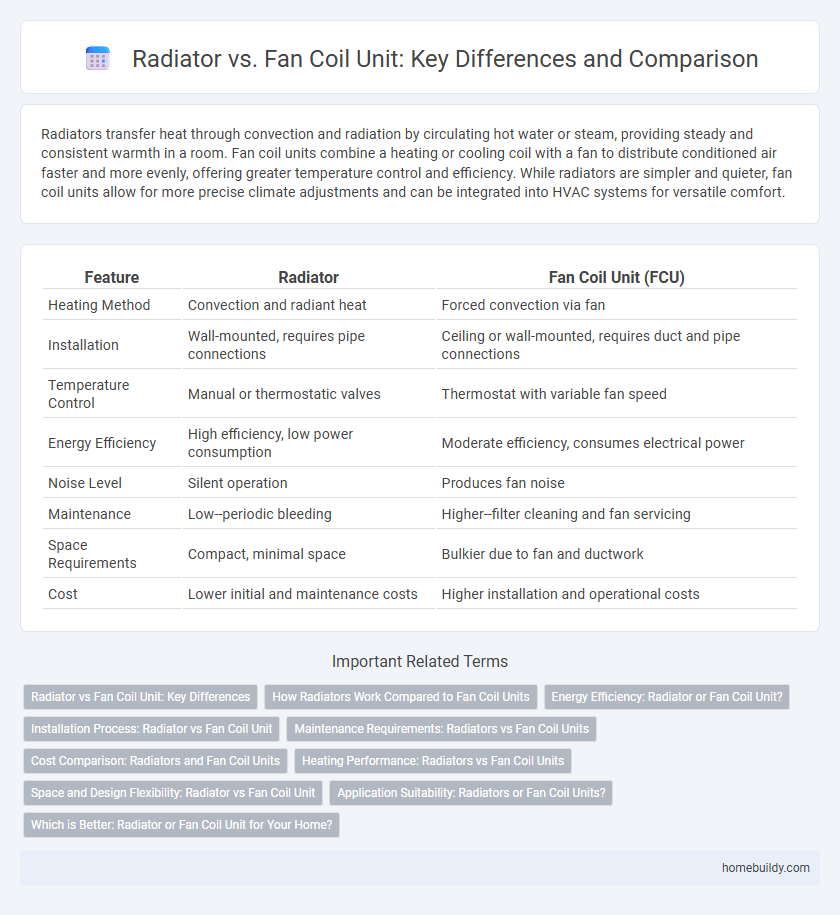Radiators transfer heat through convection and radiation by circulating hot water or steam, providing steady and consistent warmth in a room. Fan coil units combine a heating or cooling coil with a fan to distribute conditioned air faster and more evenly, offering greater temperature control and efficiency. While radiators are simpler and quieter, fan coil units allow for more precise climate adjustments and can be integrated into HVAC systems for versatile comfort.
Table of Comparison
| Feature | Radiator | Fan Coil Unit (FCU) |
|---|---|---|
| Heating Method | Convection and radiant heat | Forced convection via fan |
| Installation | Wall-mounted, requires pipe connections | Ceiling or wall-mounted, requires duct and pipe connections |
| Temperature Control | Manual or thermostatic valves | Thermostat with variable fan speed |
| Energy Efficiency | High efficiency, low power consumption | Moderate efficiency, consumes electrical power |
| Noise Level | Silent operation | Produces fan noise |
| Maintenance | Low--periodic bleeding | Higher--filter cleaning and fan servicing |
| Space Requirements | Compact, minimal space | Bulkier due to fan and ductwork |
| Cost | Lower initial and maintenance costs | Higher installation and operational costs |
Radiator vs Fan Coil Unit: Key Differences
Radiators heat rooms through natural convection by warming air directly from hot water pipes, while fan coil units use a fan to circulate air over a coil containing hot or cold water, providing both heating and cooling capabilities. Radiators are typically simpler, quieter, and require less maintenance, but fan coil units offer more precise temperature control and faster response times. The choice between a radiator and a fan coil unit depends on factors like space requirements, energy efficiency, and the need for dual climate control functionality.
How Radiators Work Compared to Fan Coil Units
Radiators operate by heating water that flows through metal panels, transferring warmth to the surrounding air via convection and radiation. Fan coil units combine a heat exchanger with a fan to circulate heated or cooled air, providing more controlled and rapid temperature adjustment. Radiators rely solely on natural airflow and do not have mechanical components like fans, resulting in quieter but slower heating compared to fan coil units.
Energy Efficiency: Radiator or Fan Coil Unit?
Radiators are hydronic heating devices that transfer heat through hot water circulation, offering high energy efficiency with minimal electricity use, especially in homes with existing boiler systems. Fan Coil Units (FCUs) use a combination of coils and fans to distribute heated or cooled air, providing faster temperature control but consuming more electricity due to fan operation. When prioritizing energy efficiency, radiators generally outperform fan coil units because they rely primarily on water-based heat transfer without additional electrical components running continuously.
Installation Process: Radiator vs Fan Coil Unit
Radiator installation involves mounting panels on walls and connecting to the central heating system, typically requiring less complex ductwork compared to fan coil units. Fan coil units demand integration with HVAC ducting and often require ceiling or wall recessing, which increases installation time and costs. Radiators offer a more straightforward and cost-effective setup for residential heating, while fan coil units provide better airflow control but with higher installation complexity.
Maintenance Requirements: Radiators vs Fan Coil Units
Radiators generally require minimal maintenance, primarily involving occasional bleeding to remove air pockets and periodic checks for leaks or corrosion. Fan coil units demand more intensive upkeep, including regular cleaning of filters, coils, and condensate drains to prevent mold buildup and ensure optimal airflow. The complexity of fan coil units often leads to higher maintenance costs and more frequent servicing compared to the relatively straightforward radiator systems.
Cost Comparison: Radiators and Fan Coil Units
Radiators typically have a lower initial installation cost compared to fan coil units due to simpler design and fewer mechanical components. Fan coil units incur higher upfront expenses as they require additional elements like fans and controls, increasing both material and labor costs. Over time, radiators often result in reduced maintenance costs given their passive operation, whereas fan coil units may demand more frequent servicing and energy consumption.
Heating Performance: Radiators vs Fan Coil Units
Radiators provide consistent, high thermal output through natural convection and radiant heat, ideal for maintaining stable room temperatures. Fan coil units use forced convection with fans to distribute warm air quickly but may create uneven heat distribution and noise. Radiators excel in efficiency and silent operation, while fan coil units offer faster heating response but at the cost of potential airflow-related discomfort.
Space and Design Flexibility: Radiator vs Fan Coil Unit
Radiators occupy less ceiling space compared to fan coil units, making them ideal for rooms where maximizing floor and ceiling area is essential. Fan coil units require more significant installation space due to ductwork and piping, limiting design flexibility in compact or intricately designed interiors. Radiators offer versatile placement options along walls, enhancing interior aesthetics without compromising functional heating efficiency.
Application Suitability: Radiators or Fan Coil Units?
Radiators excel in traditional hydronic heating systems, providing uniform warmth in residential and older commercial buildings with simpler installation and lower maintenance. Fan Coil Units offer more versatile application suitability, supporting both heating and cooling, ideal for modern HVAC systems in larger commercial or multi-zone spaces requiring precise temperature control. Selection depends on building design, climate, and specific comfort needs, with radiators favoring straightforward heating and fan coil units enabling integrated climate management.
Which is Better: Radiator or Fan Coil Unit for Your Home?
Radiators provide consistent, radiant heat ideal for traditional heating systems, while fan coil units offer faster, adjustable air distribution with integrated cooling options. Radiators excel in energy efficiency and low maintenance, whereas fan coil units support more precise temperature control and improved air circulation. Choosing between them depends on your home's insulation, heating needs, and preference for air quality versus steady warmth.
Radiator vs Fan Coil Unit Infographic

 homebuildy.com
homebuildy.com